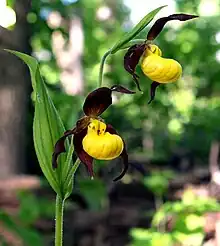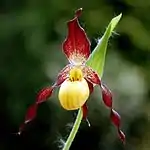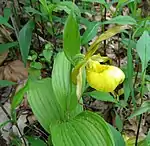| Cypripedium parviflorum | |
|---|---|
 | |
| Cypripedium parviflorum var. makasin Mackinac Island, Michigan | |
| Scientific classification | |
| Kingdom: | Plantae |
| Clade: | Tracheophytes |
| Clade: | Angiosperms |
| Clade: | Monocots |
| Order: | Asparagales |
| Family: | Orchidaceae |
| Subfamily: | Cypripedioideae |
| Genus: | Cypripedium |
| Species: | C. parviflorum |
| Binomial name | |
| Cypripedium parviflorum Salisb. | |
| Synonyms[3] | |
| |
Cypripedium parviflorum, commonly known as yellow lady's slipper[4] or moccasin flower,[5] is a lady's slipper orchid native to North America.[3] It is widespread, ranging from Alaska south to Arizona and Georgia.[6] It grows in fens, wetlands, shorelines, and damp woodlands.[7]
Description
- Plant: 16 to 60 cm tall, reported to 80 cm elsewhere: stem, bracts, and leaves pubescent; flower stem rises 10 cm above leaves; one flower, rarely two.
- Roots: few to many slender roots to 4 cm long on jointed rhizome.
- Leaves: ovate lanceolate, cauline, plicate, four to six on blooming plants, from 9 ⨉ 4 cm to 14 ⨉ 5 cm; covered with fine hairs on underside; a few hairs on topside.
- Floral bracts: ovate lanceolate bract at base of ovary, 7 ⨉ 2 cm.
- Flowers: bright yellow pouch with greenish to reddish sepals and petals; up to 10 cm high ⨉ 10 cm wide.
- Sepals: yellowish green with reddish stripes that turn to dots near pouch, fine hairs on back and edges; dorsal sepal ovate lanceolate, slightly concave, 4 ⨉ 2.2 cm; synsepal ellipitic, slightly concave; slight notch at tip, 3.2 ⨉ 1.4 cm.
- Petals: linear, acute, yellowish green with reddish stripes that turn to dots at pouch; 5.5 cm long ⨉ 0.7 cm wide; fine hairs on back along well-defined central ridge; few hairs on inner one-third toward pouch.
- Lip: bright yellow obovoid (pouch- or slipper-shaped), 3.2 cm wide ⨉ 4.0 cm high; opening 1.2 ⨉ 2.0 cm, with incurved margin; red dotted stripes on veins and faint reddish dots on inside and back of pouch.
- Column: light green with red dots at base, 1.5 cm high; two fertile anthers, one to either side; staminode yellow with red dots, arrowhead-shaped, with V form (folded); pollinia yellow sticky masses.
- Capsule: ellipsoidal, pubescent, 2.2 to 3 cm long ⨉ 0.6 to 1.3 cm in diameter
Taxonomy
C. parviflorum is a highly variable species, which is a result of both hybridization and phenotypic plasticity.[8]
Four varieties are widely recognized. They are:[9]
- C. parviflorum var. exiliens Sheviak – Alaska
- C. parviflorum var. makasin (Farwell) Sheviak – commonly called the "northern yellow lady's-slipper";[10] widely distributed over much of Canada and the northern United States
- C. parviflorum var. parviflorum – commonly called the "small yellow lady's-slipper";[11] southern part of the species range, from eastern Nebraska and eastern Oklahoma east to Virginia and New Hampshire
- C. parviflorum var. pubescens (Willdenow) O. W. Knight – commonly called the "large yellow lady's-slipper";[11] very widespread across much of United States, Canada, and St. Pierre & Miquelon; treated by many authors as a distinct species, Cypripedium pubescens
 C. parviflorum var. parviflorum, showing pubescent bract and dark maroon sepals
C. parviflorum var. parviflorum, showing pubescent bract and dark maroon sepals C. parviflorum var. pubescens, showing yellow-green sepals spotted with maroon
C. parviflorum var. pubescens, showing yellow-green sepals spotted with maroon
Distribution and habitat
Distribution
- Newfoundland to British-Columbia, south to Georgia, Arizona, and Washington; Europe.
- Newfoundland to Alaska and south to Oregon in the West.
- In the East along the Atlantic Coast, it is in every state except Florida and extends across to Louisiana and eastern Texas.
- New Mexico state: Catron, Colfax, Grant, Los Alamos, Otero, San Miguel, San Juan and Santa Fe Counties.
- Arizona state: Apache, Graham, and Greenlee Counties.
Habitat
- A more upland plant preferring subacidic to neutral soils.
- Primarily in mesic to dry-mesic upland forests, woodlands with deep humus or layers of leaf litter, shaded boggy habitats, but also in hill prairies and occasionally in wetlands with organic, well-drained, sandy soils.
- Moderate shade to nearly full sun in fir, pine, and aspen forest between 6000 and 9500 feet (1830 and 2900 meters).
- Mountain meadows and on timbered slopes.
- Dripping seeps on steep to moderately sloped canyon walls.
References
- ↑ Arditti, J., Michaud, J.D. and Healey, P.L. 1979. Morphometry of orchid seeds. I. Paphiopedilum and native California and related species of Cyprideum. American Journal of Botany 66(10): 1128.
- ↑ Arditti, J., J. D. Michaud and P. L. Healey. 1979. Morphometry of orchid seeds. I. PAPHIOPEDILUM and native California and related species of CYPRIPEDIUM. American Journal of Botany 66(10):1128-1137.
- 1 2 "Cypripedium parviflorum". World Checklist of Selected Plant Families (WCSP). Royal Botanic Gardens, Kew.
- ↑ "Cypripedium parviflorum". Go Botany. New England Wildflower Society.
- ↑ Voitk, Andrus; Voitk, Maria (2006). Orchids on the Rock: The Orchids of Newfoundland. Rocky Harbour, NL: Gros Morne Co-operating Association.
- ↑ "Cypripedium parviflorum distribution map". Flora of North America.
- ↑ "Burke Herbarium Image Collection". biology.burke.washington.edu. Retrieved 2022-07-15.
- ↑ Sheviak, Charles J. (2002). "Cypripedium parviflorum". In Flora of North America Editorial Committee (ed.). Flora of North America North of Mexico (FNA). Vol. 26. New York and Oxford: Oxford University Press – via eFloras.org, Missouri Botanical Garden, St. Louis, MO & Harvard University Herbaria, Cambridge, MA.
- ↑ "Cypripedium parviflorum". North American Orchid Conservation Center (NAOOC), Smithsonian Environmental Research Center. 2018.
- ↑ "Northern Yellow Lady's-slipper (Cypripedium parviflorum var. makasin)". Wisconsin Department of Natural Resources.
- 1 2 Weakley, Alan (2015). "Flora of the Southern and Mid-Atlantic States". Archived from the original on 2018-10-06. Retrieved 2018-01-23.
External links
 Media related to Cypripedium parviflorum at Wikimedia Commons
Media related to Cypripedium parviflorum at Wikimedia Commons Data related to Cypripedium parviflorum at Wikispecies
Data related to Cypripedium parviflorum at Wikispecies
This article is issued from Wikipedia. The text is licensed under Creative Commons - Attribution - Sharealike. Additional terms may apply for the media files.

